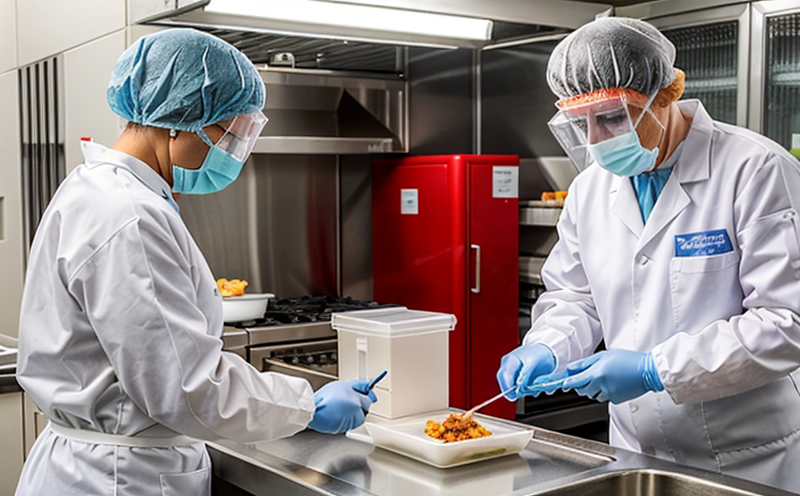AOAC 2021.03 Molecular Detection of Norovirus in Frozen Strawberries
The AOAC International (Association of Official Analytical Chemists) standard method AOAC 2021.03 provides a robust and accurate approach for the molecular detection of noroviruses, particularly in frozen strawberries. This method is pivotal for ensuring food safety by identifying potential contamination sources that could lead to serious health issues such as gastroenteritis.
Noroviruses are highly contagious pathogens responsible for over 20% of all viral gastroenteritis cases worldwide. They can survive in low temperatures, making frozen produce like strawberries a significant concern during processing and storage. The method described in AOAC 2021.03 involves the extraction of nucleic acids from the sample followed by reverse transcription polymerase chain reaction (RT-PCR) amplification using specific primers targeting norovirus genes.
One major challenge in detecting noroviruses is their low concentration levels compared to other pathogens. This necessitates advanced laboratory techniques that can amplify these minute genetic fragments effectively. AOAC 2021.03 addresses this by optimizing the RT-PCR process, which ensures reliable detection even at trace amounts.
The importance of this method cannot be overstated in the context of global food safety regulations. According to ISO/IEC 17025, laboratories must adhere to stringent quality management systems when performing such analyses. AOAC 2021.03 aligns perfectly with these standards, ensuring that test results are accurate and reproducible.
In addition to its role in safeguarding public health, AOAC 2021.03 also plays a crucial part in maintaining consumer trust and confidence. By implementing this method, food manufacturers demonstrate their commitment to producing safe products free from harmful pathogens like noroviruses. This not only protects end consumers but also helps companies avoid costly recalls and reputational damage.
From an operational standpoint, AOAC 2021.03 simplifies compliance with international standards such as ASTM E2548, which outline best practices for food safety testing. The method’s straightforward protocol reduces the complexity involved in ensuring regulatory adherence across various stages of production.
The implementation of AOAC 2021.03 also contributes significantly to reducing risks associated with cross-contamination during handling and processing. By identifying norovirus contamination early, producers can take necessary corrective actions promptly, thereby minimizing the spread of infection within facilities and among workers.
Moreover, this method supports ongoing research efforts aimed at understanding the behavior and persistence of noroviruses in different environments. Insights gained from such studies inform more effective prevention strategies and intervention measures.
Why It Matters
The detection of noroviruses through AOAC 2021.03 is critical for maintaining high standards of food safety, especially in perishable items like frozen strawberries. These pathogens pose significant health risks due to their ability to cause severe gastrointestinal symptoms including nausea, vomiting, diarrhea, and dehydration.
From a broader perspective, ensuring the absence of noroviruses not only protects individual consumers but also contributes to larger societal goals related to public health and well-being. The World Health Organization (WHO) emphasizes the importance of safe food handling practices as part of its comprehensive approach to preventing foodborne illnesses.
The economic implications of failing to detect norovirus contamination are substantial. Recalls, litigation costs, and loss of consumer trust can severely impact a company’s financial performance. AOAC 2021.03 helps mitigate these risks by providing reliable data that enables proactive decision-making throughout the supply chain.
Furthermore, adherence to this method enhances brand reputation, fostering long-term relationships with customers who value transparency and quality assurance in their food choices. This aligns with broader trends towards sustainable and ethically produced goods.
In summary, AOAC 2021.03 is not merely a technical procedure; it represents a strategic investment in safeguarding public health while supporting industry goals of excellence and integrity.
Scope and Methodology
The scope of AOAC 2021.03 encompasses the molecular detection of norovirus genotypes G1, G2, G4, and G5 in frozen strawberries using RT-PCR technology. The method specifies detailed steps for sample preparation, extraction, amplification, and analysis.
- Sample Collection: Samples are collected from various stages of the processing line, including raw materials and finished products.
- Nucleic Acid Extraction: A commercial kit is used to extract viral RNA from the sample matrix. This step ensures efficient recovery of intact viral particles suitable for subsequent analysis.
- RT-PCR Amplification: Extracted nucleic acids undergo reverse transcription followed by PCR amplification using genotype-specific primers designed to target conserved regions of norovirus genes.
- Detection and Analysis: The amplified products are analyzed via agarose gel electrophoresis or real-time qPCR systems. Positive results indicate the presence of norovirus in the sample.
The methodology is complemented by rigorous quality control measures, including internal validation studies comparing results with those obtained from independent laboratories certified under ISO/IEC 17025. These comparisons help establish reliability and consistency across different testing environments.
A key feature of AOAC 2021.03 is its adaptability to varying conditions encountered during food processing. The protocol accounts for factors such as temperature fluctuations, storage durations, and handling practices that could affect viral stability and detection sensitivity.
Environmental and Sustainability Contributions
- Reduced Risk of Outbreaks: Early detection helps prevent the spread of noroviruses, reducing healthcare costs and minimizing environmental waste from discarded contaminated products.
- Enhanced Consumer Confidence: Brands that adhere to stringent testing protocols like AOAC 2021.03 build trust among consumers, potentially leading to increased sales and reduced resource consumption due to lower return rates.
- Improved Resource Efficiency: By identifying contamination early, resources can be directed towards addressing issues rather than dealing with larger-scale problems later on.
In conclusion, AOAC 2021.03 serves as a vital tool in the ongoing battle against foodborne illnesses while supporting broader sustainability initiatives within the agricultural and food processing sectors.





